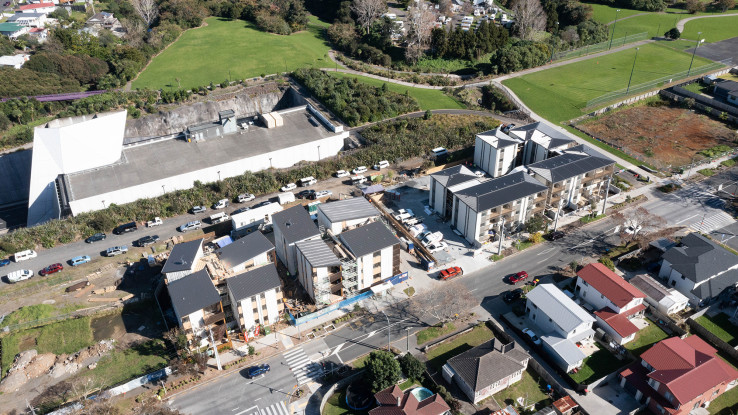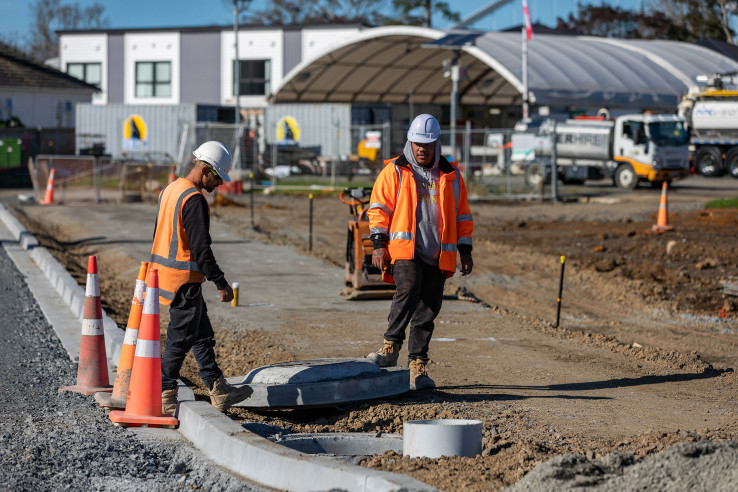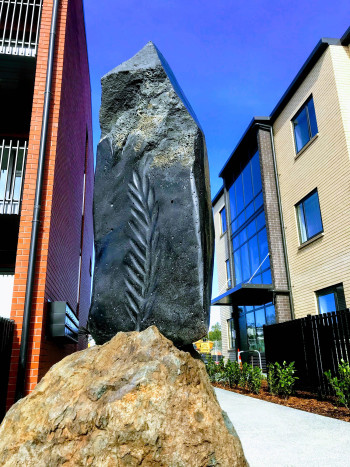Foundations for the future: how 40,000 homes are made possible
29 June 2023
Kāinga Ora is building infrastructure at scale across New Zealand. Watch this video to see how just a few of our projects are tracking, and what that means for the communities we serve.
It begins long before homes are built or whānau welcomed.
Kāinga Ora infrastructure plays a crucial role, not just in supplying homes with the electrical, water and drainage services we all need – but with the connection, shared spaces and amenity that helps communities thrive.
At Kāinga Ora, eight large-scale projects are already under way. When completed, up to 40,000 homes will be built on 490 hectares of land.
Within the next 10 years, $4.7 billion of civil design and construction will go ahead. Over the next 20 years, more than 600 individual infrastructure projects will be completed.
This month, Kāinga Ora hosted a booth at Building Nations, an annual Infrastructure New Zealand event, to provide a snapshot of just a few of these hundreds of projects planned to improve the lives of Kiwis.
Watch below to take a tour through some of the projects taking place across the country:
Porirua pipeline partners
Heavy rain in eastern Porirua’s Matahourua Crescent used to mean homes would flood.
Now, a pipe sweeps through the ground beneath a new Kāinga Ora development. It’s big enough that you could ride a bicycle through it, but instead it feeds stormwater into a park network where it will be treated.
From there, clean water flows into the Kenepuru stream.
“That pipe is only possible through the partnership we have here between ourselves, the Porirua City Council and Ngāti Toa Rangatira,” says Kāinga Ora Associate Project Director Robbie Woods.
Giant stormwater pipes form part of a network in Porirua that protects homes from flooding.
And while its size is striking, that pipe is just a small part of a much larger project. Robbie’s team leads Te Rā Nui, Eastern Porirua Development, where the partnerships he mentions will bring thousands more homes to the area, alongside the infrastructure that makes them great places to live.
“The purpose of this project is to provide meaningful, significant improvements to the wellbeing of eastern Porirua residents,” Robbie says.
As well as providing much-needed services for homes, Kāinga Ora infrastructure work in Te Rā Nui will also provide outdoor community amenity.
In Cannons Creek Park, a large urban wetland will become part of that wider stormwater network.
It will improve water quality and drainage, both for new homes and the people who already live here, “but that’s not all it can do,” he says.
“That wetland can be a place of true quality amenity for the community. It can be a place where the community can come together in nature, but within their own backyard.”
Matching the mana of Mangere

Future infrastructure solutions are being developed for Mangere, but work is already happening in the area.
Mana was tested in Mangere as record-setting rainfall hit streets and homes on Auckland Anniversary Weekend. As a result, the community came together and proved its strength.
As the area recovers and grows, Kāinga Ora and Healthy Waters will work together in the same way – hand in hand with the community – to provide infrastructure worthy of the community it serves.
Stormwater management upgrades were already happening, but January’s severe weather events mean plans for future projects are being reviewed and, wherever needed, improved to best support the community.
“This isn’t going to be just one particular feature or improvement,” says James D’Anvers, Project Director for Mangere Development.
“We’re bringing significant infrastructure upgrades to the area – improving services for people who already live in Mangere, while also paving the way for up to 10,000 new homes over the course of this development.”
Already, $16 million of infrastructure upgrades have gone ahead in Te Ararata, one of nine neighbourhoods in the Kāinga Ora Large Scale Development for the area.
And while future solutions are worked on, achievements elsewhere can provide a glimpse of what could come.
“With Moyle Park, one of our possible options is a stormwater storage area in a similar way to what we have delivered at Greenslade Reserve in Northcote Development(external link),” James says.
“Both there and at Freeland Reserve in Mt Roskill, our construction partners have built places where the community can gather and enjoy the outdoors. But these places are more than that, filling with water during heavy rain to help protect nearby homes. Both performed very well in January, and again in heavy rainfall in May.”
While a crucial step, resolving stormwater issues in Mangere is just the beginning.
“We’re going to have a significant number of warm, dry homes for people to live in with their families, as well as upgrades to the parks and the amenities,” James says.
“Mangere is going to be safer, and an even greater place to call home.”

Infrastructure work is almost complete in Ōwairaka, making way for 800 new homes.
Artful Ōwairaka
Earthworks are mostly complete in Ōwairaka, making way for about 800 new homes. But a closer look shows the benefits of infrastructure often go beyond the obvious.
Landscaping. Sea defences. Art.
Three seemingly unrelated topics all share one thing in common – they are a direct result of a community no longer prone to flooding, and a side benefit of work to enable about 800 new homes.
They are outcomes from a nearly-completed infrastructure project in Ōwairaka, Mount Albert – a neighbourhood in the 11,000-home Kāinga Ora Roskill Development.
“In one-in-a-hundred-year rain events before our system was installed, there was between 12 and 26 overflows of raw sewage into Oakley Creek Te Auaunga, the awa,” says Andrew Sandlant, Senior Development Manager.
“It’s a disaster environmentally.”
Nearly five kilometres of new stormwater network, separated from sewerage lines into pipes sometimes big enough to walk through, have brought an end to that disaster.

Contractors laid nearly 5 kilometres of new stormwater pipes in Ōwairaka.
As a result, Oakley Creek is cleaner. Ōwairaka homes and streets have remained free of floodwaters as Mother Nature continues to test the upgrades.
“This new network is a crucial first step in us delivering more homes for Ōwairaka, but Kāinga Ora infrastructure upgrades are for the whole community, whoever calls it home,” says Andrew.
“Existing residents have been incredibly patient during some pretty disruptive earthworks, so it’s great that we can make sure they experience some early benefits.”
Those disruptive earthworks came from contractors having to break large chunks of basalt, ancient volcanic rock, sometimes digging up to six metres in order to upgrade the stormwater system.
It was challenging work – close to homes, existing pipes and power lines – so the team used ‘pepper drilling’, where rock is broken in place and filled with an expanding grout, to reduce noise and minimise disruption.

A carving made from volcanic rock excavated from Ōwairaka.
About 7,000 cubic metres of rock was pulled from the earth – or nearly 150,000 loads in your trusty wheelbarrow – and donated to be reused in streams, water courses, to build sea defences and, in at least one case, to create art.
As a result, a large basalt shard carved into a beautiful sculpture now sits in the courtyard of a new housing development in another Auckland suburb.
That rock was once an example of a community sacrificing peace and quiet for a brighter future. Now, it welcomes residents home.
Ōwairaka – by the numbers
- 4.7km of new stormwater pipes
- 99 manholes
- 1650mm – the diameter of some of the new stormwater pipes
- 800 new homes enabled
- 1.3km of new wastewater pipes
- 9km of power and communications cables moved underground
- 3 new stormwater outlets
- 13,000 new plants and trees
- 68 new streetlights
- 2km of upgraded roads
- 6.2km of new concrete footpaths
- 650m of new roads
- 435m – the length of sliplined and cured-in-place pipes, fed underground without the need to dig trenches
- $35 million – the total cost of the infrastructure upgrades
